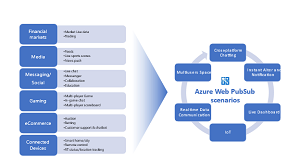News
New Azure Web PubSub Unveiled for Real-time WebSocket Apps
Microsoft is previewing a new Azure Web PubSub service used to create real-time applications based on WebSockets communication tech.
Because WebSockets allows for full-duplex communication channels over a single TCP connection, it can be used to open a two-way interactive communication session between the user's browser and a server.
 [Click on image for larger view.] Azure Web PubSub (source: Microsoft).
[Click on image for larger view.] Azure Web PubSub (source: Microsoft).
Just some of the many real-time WebSockets use cases include:
- High frequency data updates: gaming, voting, polling, auction.
- Live dashboards and monitoring: company dashboard, financial market data, instant sales update, multi-player game leader board, and IoT monitoring.
- Cross-platform live chat: live chat room, chat bot, on-line customer support, real-time shopping assistant, messenger, in-game chat, and so on.
- Real-time location on map: logistic tracking, delivery status tracking, transportation status updates, GPS apps.
- Real-time targeted ads: personalized real-time push ads and offers, interactive ads.
- Collaborative apps: coauthoring, whiteboard apps and team meeting software.
- Push instant notifications: social network, email, game, travel alert.
- Real-time broadcasting: live audio/video broadcasting, live captioning, translating, events/news broadcasting.
- IoT and connected devices: real-time IoT metrics, remote control, real-time status, and location tracking.
- Automation: real-time trigger from upstream events.
"WebSocket is a standardized protocol that provides full-duplex communication," Microsoft said in an April 29 blog post announcing the preview of Azure Web PubSub. "It is key to building efficient real-time web interactions and is supported by all major browsers as well as web servers. Azure Web PubSub enables you to use WebSockets and the publish-subscribe pattern to easily build real-time web applications, like live monitoring dashboards, cross-platform live chat, real-time location on maps, and more."
The fully managed Azure Web PubSub service provides built-in support for large-scale client connections and highly available architectures, Microsoft said. It lets developers use popular programming languages like C#, Python and Java to connect to WebSocket APIs.
The new service is integrated with Azure Functions for serverless cloud apps that typically use code blocks -- functions -- that are triggered by various types of events.
"Serverless solutions for real-time applications -- using Azure Functions and Azure Web PubSub service -- allow you to write less code, maintain less infrastructure, and save on costs," Microsoft said. "Consider a location tracking live dashboard. You can use Azure Functions to integrate and process the location data from IoT devices, and then leverage Azure Web PubSub service to broadcast the location data to multiple live dashboard clients to visualize real-time location information for your customers."
The preview tech differs from the existing Azure SignalR Service that's based on the SignalR library widely used with .NET, as Azure Web PubSub can be used with any platform supporting WebSockets to build sophisticated applications, Microsoft said.
More resources include:
About the Author
David Ramel is an editor and writer at Converge 360.